Astronomers have discovered a spectacular first in terms of star clusters and planet-forming discs of gas, a system–GW Orionis–with a warped disc with torn out inner rings. The team believes that the disc’s odd shape –which defies the common view of a flat plane orbiting planets and gas discs–was created when the misalignment of the three stars at the centre of the disc caused it to fracture into distinct rings.
As well as being extraordinary in its own right, the astronomers believe that the warped disc could harbour exotic and strange exoplanets– not unlike Tatooine in Star Wars series– which formed within the inclined rings and are, for now, hidden from view.
“The idea that planets form in neatly-arranged, flat discs around young stars goes back to the 18th century and Kant and Laplace,” research team-leader Stefan Kraus, a professor of astrophysics at the University of Exeter in the UK, tells ZME Science. “Our images reveal an extreme case where the disc is not flat at all, but is warped and has a misaligned ring that has broken away from the disc.”
“‘Tatooine’ planets that orbit around 2 or 3 suns have already been envisioned by science fiction and some Tatooine exoplanets have already been found. Here, we observe how such planets form and find that they can form on extreme, highly inclined orbits — in configurations that are completely different from the ‘neat’ arrangement observed in the Solar System.”
Stefan Kraus, professor of astrophysics, the University of Exeter
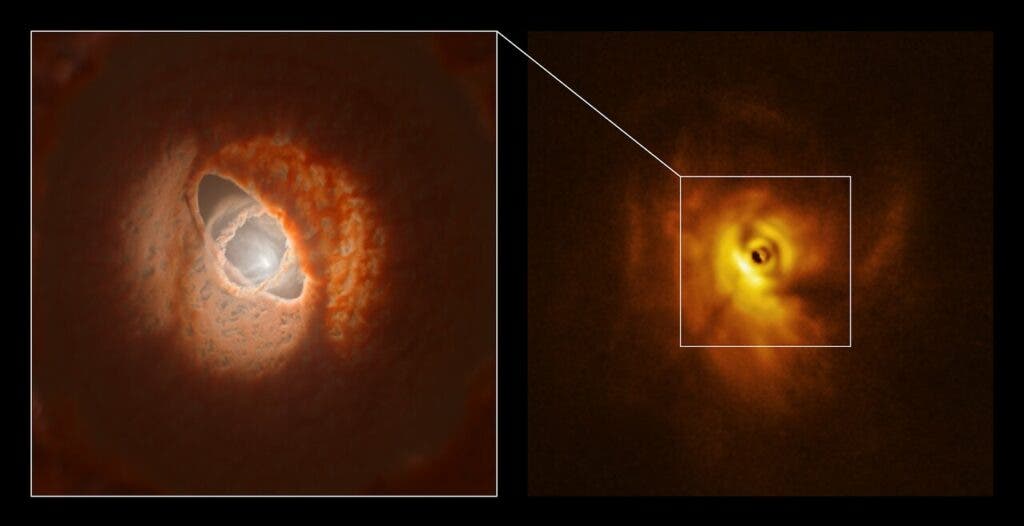
GW Orionis is Twisted
The team saw the warped shape of the system GW Orionis, which sits 1300 light-years from Earth in the constellation of Orion, in observations made by the Very Large Telescope (VLT) operated by European Southern Observatory (ESO), and the Atacama Large Millimeter/ submillimeter Array (ALMA) based in the Chilean desert. But, properly envisioning this shape and its cause meant studying the system for a staggering 11 years.
“The most important result from our study is that we can identify the cause for the misalignments and link it to the ’disc tearing’ effect that has been proposed by theorists 8 years ago, but has not been observed so far,” Kraus continues. “For this, it was essential to measure the orbital motion of the three stars that are in the centre of the system over their full 11-year orbital period.
“We found that the three stars do not orbit in the same plane, but their orbits are misaligned with respect to each other and with respect to the disc.”
Stefan Kraus, professor of astrophysics, the University of Exeter
“We have observed GW Orionis, a triple star system surrounded by a planet-forming disc, with several different telescopes including the VLT and ALMA. After observing the three stars for several years, our team was able to calculate the orbits very accurately,” team member Alison Young of the Universities of Exeter and Leicester tells ZME Science. “This data allowed us to build a detailed computer model of the system, which predicted that the disc would be bent and even torn to form a separate inner ring.”
“A couple of years later when we received the data back from the VLT and ALMA, the image of a disc bent and even torn to form a separate inner ring, were stunning.”
Alison Young of the Universities of Exeter and Leicester
A paper detailing their work is published in the journal Science.
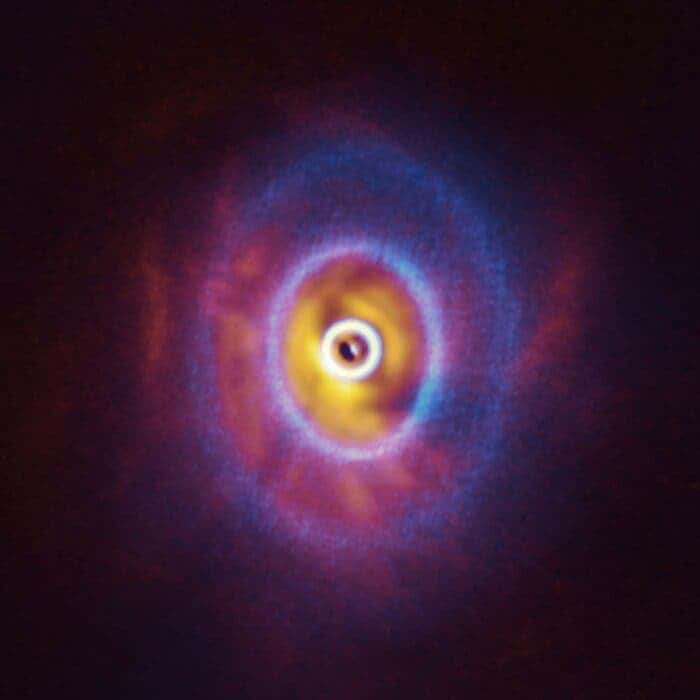
That Tears It! How GW Orionis got warped
The images of GW Orionis that the astronomers collected represent the first visualisation of disc-tearing ever captured by researchers. This tearing and the ‘warped’ effect it created marks this out as a planetary system exceptionally different from the solar system.
“The radial shadows in the VLT SPHERE image are clear evidence that the ring is tilted. To form a narrow shadow like this on the disc you need a fairly opaque ring of material that is at an angle to the disc surface blocking the starlight,” Young explains. “This result is consistent with some modelling done by members of the team which worked out the most likely orientations of the components of the system.”
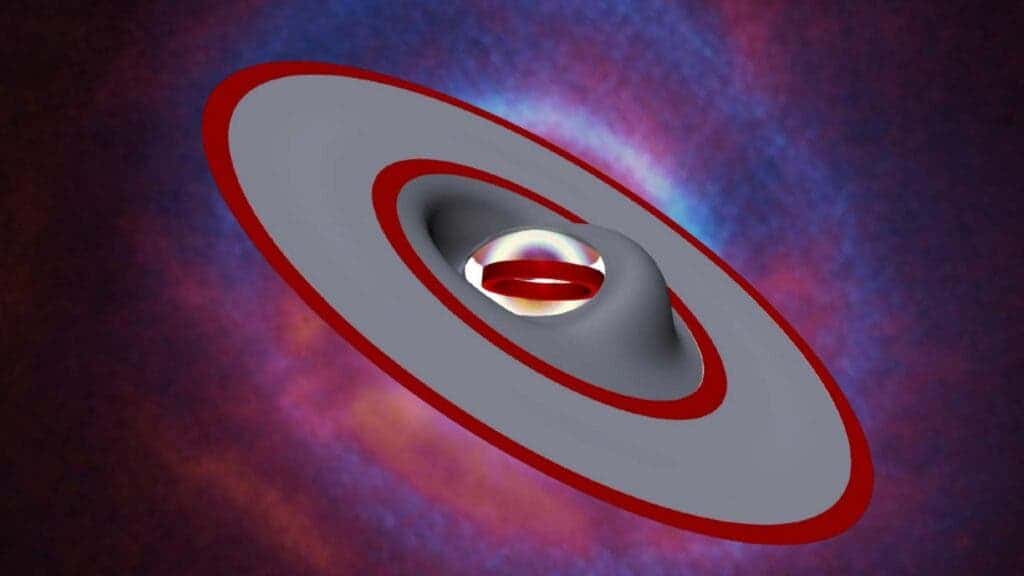
“This system is unusual because the orbits of the three stars are misaligned, unlike the planets in the solar system they do not orbit in the same plane, and these stars host a large disc that is also tilted relative to their orbits,” Young continues. “We see all sorts of intriguing structures now in images of protoplanetary discs but this is the first direct evidence of the disc tearing effect.”
The observations also gave the researchers an idea of the vast scale of the GW Orionis disc.
“The ring harbours about 30 Earth masses of dust, which is likely sufficient for planet formation to occur in the ring. Any planets formed within the misaligned ring will orbit the star on highly oblique orbits and we predict that many planets on oblique, wide-separation orbits will be discovered in future planet imaging surveys.”
Stefan Kraus, professor of astrophysics, the University of Exeter
As well as being able to reconstruct the torn disc of GW Orionis from the ALMA data in conjunction with data collected from several other telescopes, the team has been able to piece together the process by which this tearing likely occurred. They conclude that it could be a result of those three, misaligned stars. Something that initially came as a surprise to the astronomers.
“One very intriguing aspect of GW Orionis is that the orbits of the stars are strongly misaligned with respect to each other, and they are also strongly titled with respect to the large-scale disc. This wasn’t clear at the time when we started the study and became only apparent after monitoring the orbit motion for the full 11-years orbital period.”
Stefan Kraus, professor of astrophysics, the University of Exeter
Alison Young explains that because the disc surrounds three stars and the orbits of those stars are misaligned with respect to each other, the gravitational pull on the disc is not the same all the way around. This means that the gas and dust orbiting in the disc around all three stars feels a different force at different positions in the disc. This is what tears the disc apart into separate rings.
“Our study shows that the strong distortions observed in the disc– such as the warp and torn-away ring–can be explained by the conflicting gravitational pull from the 3 stars. The key aspect is that the orbits are strongly misaligned with the disc.
Stefan Kraus, professor of astrophysics, the University of Exeter
How Warped Rings and Multiple Suns Effect Exoplanets
One interesting consequence of the warping of this gas and dust is that fact that it will wrap rings of material around any planets forming within it. This tearing also has a marked effect on these exoplanets’ orbits. This leads to conditions that would make the exoplanets in the GW Orionis system significantly different from planets in our own solar system.
“The planets in our solar system all have more-or-less aligned orbits. Any planets that form in the warped disc or misaligned ring could have highly inclined orbits,” says Young. “Further out, the disc is flatter and any planets that form there are likely to orbit in a similar plane to the disc. Of course, any planets that form in the GW Orionis system will also have three suns!”
Kraus points out that planets with oblique orbits have been identified before–particularly in the case of ‘Hot Jupiters’–planets with a mass and size comparable to the solar system’s largest planet, but that orbit closer to their star and transit across its face.
“Hot Jupiters orbit their stars very close in, and it is clear that they have not formed on the oblique orbits were we observe them. Instead, they must have been moved onto these orbits through migration processes,” Kraus says. “We haven’t found yet any long-period planets on oblique orbits–comparable to Earth or Jupiter. However, our research shows that such planets could form in the torn-apart rings around multiple systems.
“Given that about half of all stars are found in multiple systems, there could be a huge population of such long-period planets with high obliquity.”
Stefan Kraus, professor of astrophysics, the University of Exeter

Existing under the glare of three suns would make the planets in the GW Orionis system similar in some ways to an exoplanet discovered by astronomers from the University of Arizona in 2016.
The young exoplanet HD 131399Ab, 340 light-years from Earth in the constellation Centaurus, has a scorching hot temperature of around 580 C and exists in a state of constant daytime. It too has been compared to the planet of Tatooine from the Star Wars series. But Straus believes the planets in GW Orionis could be much cooler than this–or could alternate between cool and hot climates.
“Planets on such orbits could have stable atmospheric conditions, but would be ‘ice worlds’ with low temperatures on their surfaces,” Kraus says. “Planets that might have formed in the circumstellar/ circumbinary disc would experience extreme temperature variations, depending on where they are on their orbit. This should result in a strongly variable climate.”
Further Questions and Future Investigations: Delving Deeper into GW Orionis
Questions still remain about the GW Orionis system especially in light of research from another team who investigated the system with the ALMA telescope. This work-published in The Astrophysical Journal Letters earlier this year– suggests that our understanding of how the disc became warped is missing a vital component. “We think that the presence of a planet between these rings is needed to explain why the disc tore apart,” says Jiaqing Bi of the University of Victoria, Canada, lead author of a paper.
Speaking to ZME Science exclusively, Kraus addresses this earlier research: “This alternative scenario, where a yet-unseen planet located between the inner and middle ring might be the cause for the unusual disc shape, is more speculative, as such as planet has not been found yet,” the astrophysicist says. “Also, the paper’s authors had less information on the 3-dimensional shape of the disk as their ALMA observations had 6x lower solution and they did not have scattered-light images showing the shadows. Plus, they did not know the full orbits.”
Young continues by adding one future question regarding GW Orionis she would like to see answered also concerns the mechanism that caused the warping of the as and dust planet-forming disc.
“An important question we need to look at is how these systems came to be misaligned in the first place. Was the disc formed with the stars, did the material forming the disc arrive later, or did the system get disrupted at some point?”
Alison Young of the Universities of Exeter and Leicester
“Think of a star as a spinning top tilted at an angle,” the researcher suggests. “We want to find out how tilted the stars are so we can check whether a star’s tilt–or ‘spin axis’– matches the tilt of its disc, or if the stars in a binary or triple system have the same or different tilts.”
Some members of the team that made this discovery are currently developing a technique for measuring the spin axis of stars which could massively aid the understanding of how these systems formed.
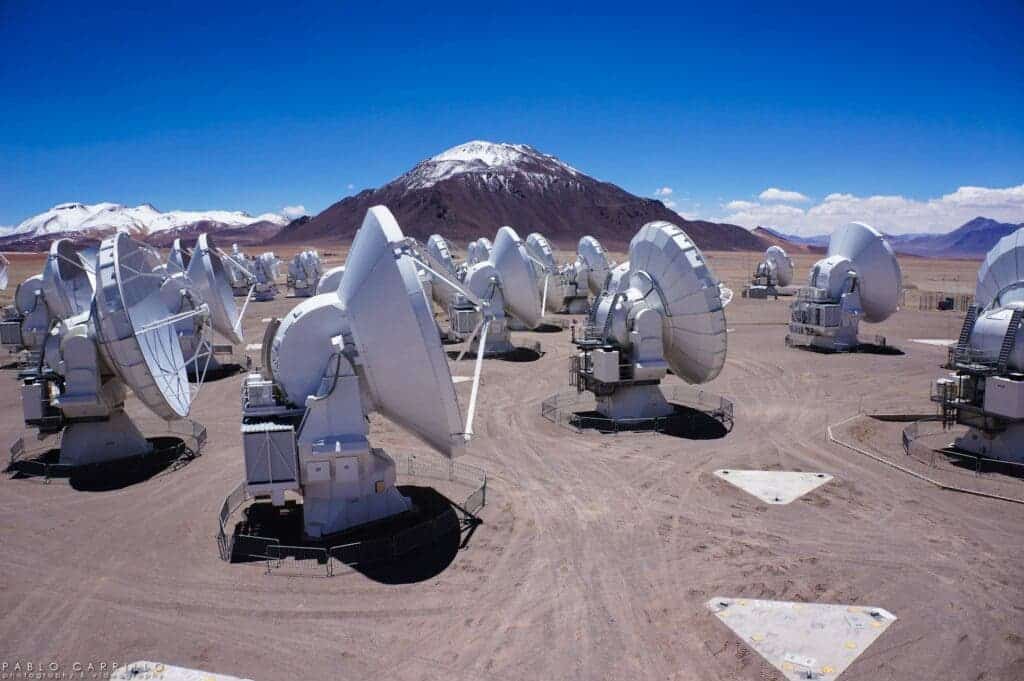
Remembering that whilst this is not the first system discovered with such a warped disc, it is the first with a directly observed torn disc. This means the key to answering lingering questions likely lies in the direct observation of more systems that share features with GW Orionis.
“There are a few planet-forming discs that show some evidence of warping but for these, it is unclear what is causing the effect or there is an alternative scenario that can explain the observations, that has not been ruled out yet,” adds Young. “This is the first time that disc tearing has been directly observed and the only system so far for which we can link the structure with the physical mechanism behind it.”
Young suggests that the results of a larger survey performed by the ALMA array could provide clearer information about the motion of gas in planet-forming discs and their chemical composition, thus helping the team gather more information about the GW Orionis disc.
“We would like to obtain high-resolution observations of molecular emission from GW Orionis to shed more light on the motion of the gas in the disc and perhaps reveal any planets that are forming,” she explains. “Of course, we also are keen to understand if there are differences in how planets might form in warped discs compared to flat discs around a single star and we will be working on new computer models to look at this, using what we have learned from our observations.”
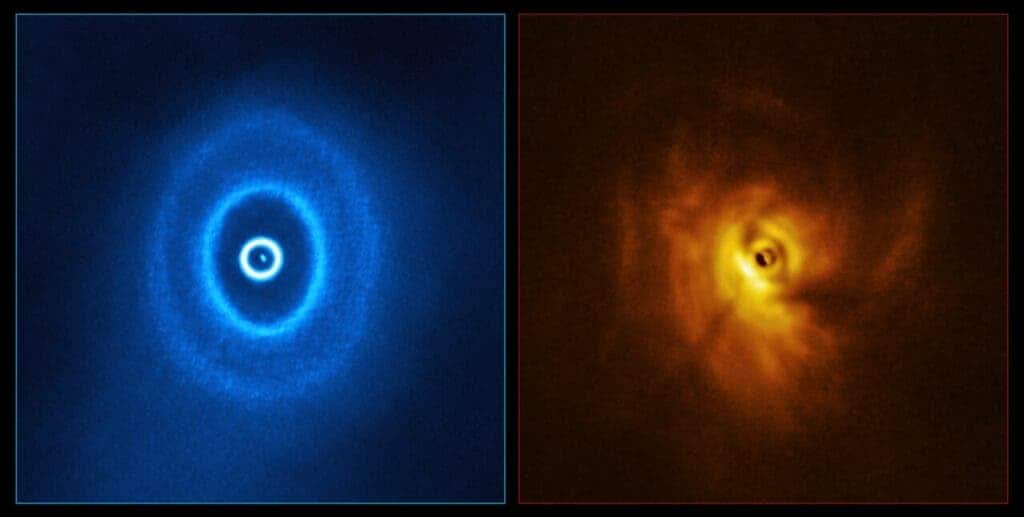
Young explains the importance of the GW Orionis images the team captured, whilst focusing on one image that for her, brought home the significance of the investigation in which she played a part.
“I find the SPHERE image [above left] in particular amazing because we can really see the disc is a 3-dimensional structure with a surface covered in bumps and shadows. We are looking at what could eventually become an unusual type of planetary system in the very process of forming.”
Alison Young of the Universities of Exeter and Leicester
For Stefan Kraus, the beauty of investigating a system such as GW Orionis is the wonder to imagining what it is like to stand on the surface of such a world and stare up into sky. Kraus concludes: “Half of the sky would be covered by a massive disc warp that is being illuminated by the 3 stars, intercepted by narrow shadows that are cast by the misaligned disc ring.”
“I find it fascinating to imagine how the sky would look like from any planet in such a system — one would see not only the 3 stars dancing around each other at different speeds but also a massive dust ring extending over the whole firmament.”
Stefan Kraus, professor of astrophysics, the University of Exeter






